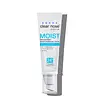What's inside
What's inside
 Key Ingredients
Key Ingredients

 Benefits
Benefits

 Concerns
Concerns

 Ingredients Side-by-side
Ingredients Side-by-side

Water
Skin ConditioningPropanediol
SolventGlycerin
HumectantCaprylic/Capric Triglyceride
MaskingCetearyl Olivate
Niacinamide
SmoothingCaprylyl Glycol
EmollientCeramide NP
Skin ConditioningCeramide AP
Skin ConditioningPhytosphingosine
Skin ConditioningPanthenol
Skin ConditioningCeramide EOP
Skin ConditioningSqualane
EmollientCholesterol
EmollientC13-14 Isoparaffin
EmollientCetyl Palmitate
EmollientPropylene Glycol
HumectantHydrolyzed Sodium Hyaluronate
Skin ConditioningHydrolyzed Hyaluronic Acid
HumectantSodium Hyaluronate
HumectantSodium Acetylated Hyaluronate
HumectantMelaleuca Alternifolia Leaf Extract
PerfumingHamamelis Virginiana Leaf Extract
Skin ConditioningHyaluronic Acid
HumectantPotassium Hydroxide
Buffering1,2-Hexanediol
Skin ConditioningLactic Acid
BufferingVitis Vinifera Seed Oil
EmollientEthylhexylglycerin
Skin ConditioningTocopheryl Acetate
AntioxidantPolyacrylamide
Laureth-7
EmulsifyingCeteareth-12
EmulsifyingSorbitan Olivate
EmulsifyingButylene Glycol
HumectantGlucose
HumectantDisodium EDTA
Cetearyl Alcohol
EmollientHydroxypropyltrimonium Hyaluronate
Potassium Cetyl Phosphate
EmulsifyingSodium Lauroyl Lactylate
EmulsifyingAcrylates/C10-30 Alkyl Acrylate Crosspolymer
Emulsion StabilisingMyristyl Myristate
EmollientXanthan Gum
EmulsifyingGlyceryl Stearate
EmollientCeteareth-20
CleansingCarbomer
Emulsion StabilisingPhenoxyethanol
PreservativeChlorphenesin
AntimicrobialSodium Benzoate
MaskingPotassium Sorbate
PreservativeSodium Hyaluronate Crosspolymer
HumectantPotassium Hyaluronate
Skin ConditioningChondrus Crispus Extract
Skin ConditioningSophora Japonica Flower Extract
Skin ProtectingWater, Propanediol, Glycerin, Caprylic/Capric Triglyceride, Cetearyl Olivate, Niacinamide, Caprylyl Glycol, Ceramide NP, Ceramide AP, Phytosphingosine, Panthenol, Ceramide EOP, Squalane, Cholesterol, C13-14 Isoparaffin, Cetyl Palmitate, Propylene Glycol, Hydrolyzed Sodium Hyaluronate, Hydrolyzed Hyaluronic Acid, Sodium Hyaluronate, Sodium Acetylated Hyaluronate, Melaleuca Alternifolia Leaf Extract, Hamamelis Virginiana Leaf Extract, Hyaluronic Acid, Potassium Hydroxide, 1,2-Hexanediol, Lactic Acid, Vitis Vinifera Seed Oil, Ethylhexylglycerin, Tocopheryl Acetate, Polyacrylamide, Laureth-7, Ceteareth-12, Sorbitan Olivate, Butylene Glycol, Glucose, Disodium EDTA, Cetearyl Alcohol, Hydroxypropyltrimonium Hyaluronate, Potassium Cetyl Phosphate, Sodium Lauroyl Lactylate, Acrylates/C10-30 Alkyl Acrylate Crosspolymer, Myristyl Myristate, Xanthan Gum, Glyceryl Stearate, Ceteareth-20, Carbomer, Phenoxyethanol, Chlorphenesin, Sodium Benzoate, Potassium Sorbate, Sodium Hyaluronate Crosspolymer, Potassium Hyaluronate, Chondrus Crispus Extract, Sophora Japonica Flower Extract
Water
Skin ConditioningGlycerin
HumectantDipropylene Glycol
HumectantCetyl Ethylhexanoate
EmollientPentylene Glycol
Skin ConditioningDiglycerin
HumectantTrehalose
HumectantPEG-60 Hydrogenated Castor Oil
EmulsifyingGalactomyces/Milk Ferment Filtrate
HumectantGlycine Soja Seed Extract
Skin ConditioningGlycine Soja Protein
EmulsifyingPEG-240/Hdi Copolymer Bis-Decyltetradeceth-20 Ether
StabilisingAcrylates/C10-30 Alkyl Acrylate Crosspolymer
Emulsion StabilisingButylene Glycol
HumectantPEG-32
HumectantAlcohol
AntimicrobialEthylhexylglycerin
Skin ConditioningGlycyrrhiza Glabra Root Extract
BleachingDiphenylsiloxy Phenyl Trimethicone
Skin ConditioningDimethicone
EmollientSodium Stearoyl Glutamate
CleansingTocopherol
AntioxidantTriethylhexanoin
MaskingBehenyl Alcohol
EmollientPentasodium Pentetate
Sodium Hydroxide
BufferingPhenoxyethanol
PreservativeWater, Glycerin, Dipropylene Glycol, Cetyl Ethylhexanoate, Pentylene Glycol, Diglycerin, Trehalose, PEG-60 Hydrogenated Castor Oil, Galactomyces/Milk Ferment Filtrate, Glycine Soja Seed Extract, Glycine Soja Protein, PEG-240/Hdi Copolymer Bis-Decyltetradeceth-20 Ether, Acrylates/C10-30 Alkyl Acrylate Crosspolymer, Butylene Glycol, PEG-32, Alcohol, Ethylhexylglycerin, Glycyrrhiza Glabra Root Extract, Diphenylsiloxy Phenyl Trimethicone, Dimethicone, Sodium Stearoyl Glutamate, Tocopherol, Triethylhexanoin, Behenyl Alcohol, Pentasodium Pentetate, Sodium Hydroxide, Phenoxyethanol
 Reviews
Reviews

Ingredients Explained
These ingredients are found in both products.
Ingredients higher up in an ingredient list are typically present in a larger amount.
Acrylates/C10-30 Alkyl Acrylate Crosspolymer is a synthetic polymer. It is used to thicken and improve the texture of products. Due to its properties, it can prevent water and oil ingredients from separating.
Butylene Glycol (or BG) is used within cosmetic products for a few different reasons:
Overall, Butylene Glycol is a safe and well-rounded ingredient that works well with other ingredients.
Though this ingredient works well with most skin types, some people with sensitive skin may experience a reaction such as allergic rashes, closed comedones, or itchiness.
Learn more about Butylene GlycolEthylhexylglycerin (we can't pronounce this either) is commonly used as a preservative and skin softener. It is derived from glyceryl.
You might see Ethylhexylglycerin often paired with other preservatives such as phenoxyethanol. Ethylhexylglycerin has been found to increase the effectiveness of these other preservatives.
Glycerin is already naturally found in your skin. It helps moisturize and protect your skin.
A study from 2016 found glycerin to be more effective as a humectant than AHAs and hyaluronic acid.
As a humectant, it helps the skin stay hydrated by pulling moisture to your skin. The low molecular weight of glycerin allows it to pull moisture into the deeper layers of your skin.
Hydrated skin improves your skin barrier; Your skin barrier helps protect against irritants and bacteria.
Glycerin has also been found to have antimicrobial and antiviral properties. Due to these properties, glycerin is often used in wound and burn treatments.
In cosmetics, glycerin is usually derived from plants such as soybean or palm. However, it can also be sourced from animals, such as tallow or animal fat.
This ingredient is organic, colorless, odorless, and non-toxic.
Glycerin is the name for this ingredient in American English. British English uses Glycerol/Glycerine.
Learn more about GlycerinPhenoxyethanol is a preservative that has germicide, antimicrobial, and aromatic properties. Studies show that phenoxyethanol can prevent microbial growth. By itself, it has a scent that is similar to that of a rose.
It's often used in formulations along with Caprylyl Glycol to preserve the shelf life of products.
Water. It's the most common cosmetic ingredient of all. You'll usually see it at the top of ingredient lists, meaning that it makes up the largest part of the product.
So why is it so popular? Water most often acts as a solvent - this means that it helps dissolve other ingredients into the formulation.
You'll also recognize water as that liquid we all need to stay alive. If you see this, drink a glass of water. Stay hydrated!
Learn more about Water